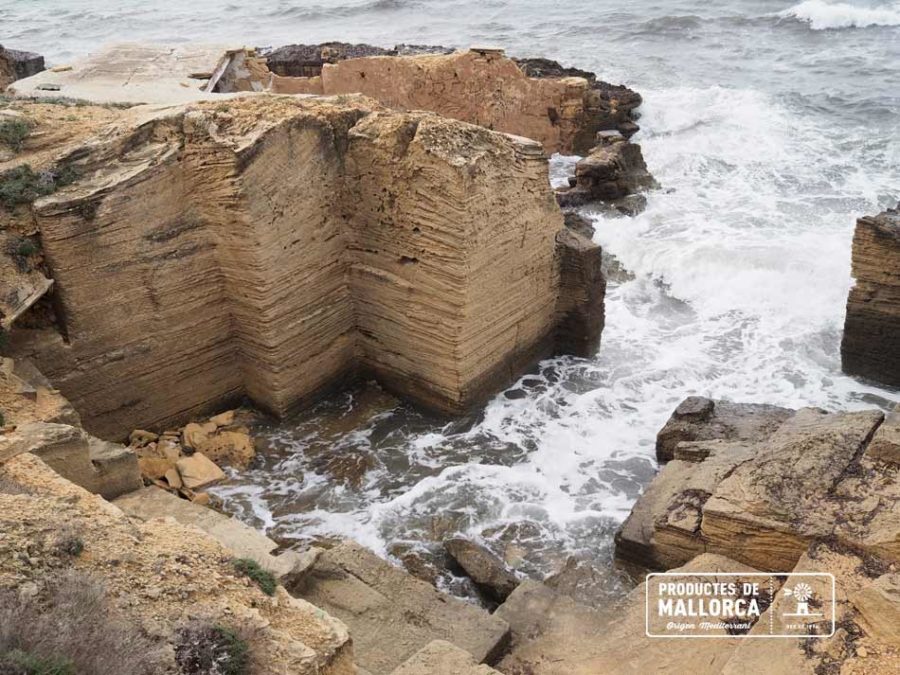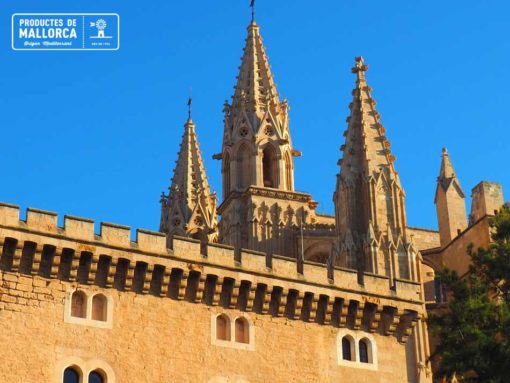
Building with marés
Building with marés
The extraction of material (for building with marés) has shaped the coast of Mallorca for centuries.
If you have ever visited the southern coast of Mallorca, in some places you may have been surprised by the whimsical shapes of the rocks. Have they been cut by the knife of a giant?
It really looks like it, because those straight lines and those quadrangular shapes are not what Nature or the sea typically sculpt. It is curious to observe those rocks, and try to imagine how all that landscape originated, which contrasts so much with the waves of the Mediterranean.
Marés, a very abundant material in the Balearic Islands
The marés is a type of stone formed by marine sand that was compressed during the Quaternary period. It is therefore a type of sandstone.
The whole coast from Coll d’En Rabassa to Santanyí, and also certain areas in the municipalities of Llucmajor, Porreres and Muro, are suppliers of marés, of different qualities.
Characteristics of Marés as a building material
The ease with which it can be worked has made it the most widely used natural material in the construction of all types of buildings in the Balearic Islands.
The quality of the marés is measured by the thickness of its grain and its density, its colour and its hardness. With the lower quality marés, called common marés, walls are built that later need to be plastered. The higher-quality marés is used on exposed walls, and is used to build arches, cornices and decorative elements.
In general, marés is a material that transpires and lets humidity pass through. Therefore, in Mallorca it is ideal for a house in summer. This same peculiarity becomes a bad friend in winter, when the humidity so characteristic of the Balearic Islands is combined with low temperatures.
It is easy to see it in buildings, especially in the villages, on party walls, without plastering. But you can also see it in all kinds of old buildings, even palaces, churches and even the walls that protected the city of Palma.
Craftsmen of the marés
The old craft of TRENCADOR DE MARES corresponded to the workers who were in charge of selecting and cutting the marés with rudimentary tools that, since the craft was mechanized, have been abandoned. The traditional technique was transmitted from parents to children, and given its difficulty, it was better paid than the rest of the guilds.

Marés Quarries
Currently there are 16 marés quarries (locally called pedreres de marés) active in Mallorca: one in Campos, six in Felanitx, four in Llucmajor, one in Manacor, one in Muro, one in Petra, one in Santa Margalida and one in Santanyí.
In Menorca there are still three active quarries, and it is estimated that in less than five years they will be exhausted. They are the Alcafar Nou quarry, the S’Hostal en Lithica quarry and the Son Salord quarry.
These are open-air quarries, in which the quarries are deepened and selected according to quality.
The days of the construction with marés are numbered due to the exhaustion of the quarries.
Marés on the coast
The marés obtained on the coast was lowered into barges and transported by sea to its destination. In this way, the Cathedral of Palma was built with seawater coming from the easternmost part of the bay of Palma (Pedreres de la Seu), on the other side of the Regana cape.
A large number of workers from the Llucmajor area took part in these tasks, who spent weeks camping there and living in very difficult conditions.
Curious facts
You know that the marés is a type of sandstone, which was formed by compression of sea sand in the Quaternary era. But perhaps what you haven’t thought about is that this sea sand was previously formed by the decomposition of the shells of marine animals.
So actually the cathedral of Palma is built with the remains of sea shells. Don’t you find that fascinating?

Do you know the Lonja, Bellver Castle and the Royal Palace of the Almudaina in Palma? And the Palau dels Reis de Mallorca in Perpignan (France)?
For all these symbolic buildings were the result of building with marés, and although this type of stone erodes somewhat easily, they are still perfectly standing after almost 800 years.
Ninety years ago, pieces of marés were still sent for the restoration and renovation of Castelnuovo in Naples. This castle had been built during the domination of the Crown of Aragon and of course had been made with Marés de Mallorca!
Video of the extraction of marés in the traditional way, in Menorca:
With this construction technique, true jewels of Mallorcan architecture were built, such as the cathedral of Palma. Follow the link to an interesting article about it: Cathedral of Palma
